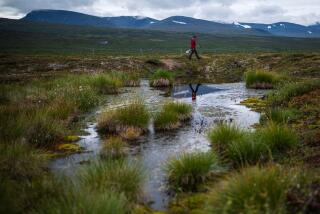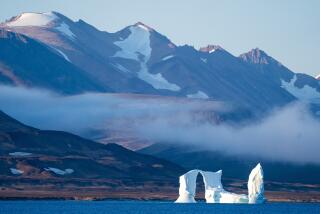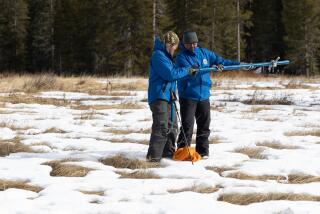Warming effect of melting ice fields stronger, report finds
- Share via
The dramatic shrinking of Arctic Sea ice and the Northern Hemisphere’s glaciers and snowfields has reduced the radiation of sunlight back into space more than scientists previously predicted, according to a new study in the journal Nature Geoscience.
As a result, the ocean and land mass exposed by the melting ice and snow have absorbed more heat, contributing to global warming.
The “albedo” effect, in which the white cover reflects radiation from sunshine, has been calculated in numerous computer-generated climate models. But the new study goes beyond those theoretical calculations. Using field measurements and satellite observations, a team led by University of Michigan researcher Mark Flanner found that the warming effect of the loss of snow and ice is “substantially larger” than was predicted in the estimates of 18 climate models.
On average, Earth’s temperature has risen about 1.4 degrees Fahrenheit since the Industrial Revolution, driven by the increase in heat-trapping carbon dioxide and other gases released by the burning of coal and oil. But the warming effect is uneven, with polar regions heating up much more than the lower latitudes.
Global warming skeptics have often claimed that climate models exaggerate ongoing climate change. But the new study of Arctic Sea ice and snow on land documented the opposite: Climate models, in this important area, underestimate the effects. The findings add urgency to demands that the United States, China and other major greenhouse gas polluters curb their emissions and switch to cleaner fuels.
Flanner and his colleagues measured ice and snow between 1979 and 2008. They found that ice and snow in the Northern Hemisphere are now reflecting on average 3.3 watts of solar energy per square meter back to space, a reduction of 0.45 watts per square meter over three decades.
In snow- and ice-covered regions, Flanner said, “observations show a stronger response to recent warming than anticipated.” But he noted that the Arctic melting is just one of the major factors that will influence the future climate. “Changes in atmospheric water and clouds are the two other big players,” he said.
More to Read
Sign up for Essential California
The most important California stories and recommendations in your inbox every morning.
You may occasionally receive promotional content from the Los Angeles Times.











